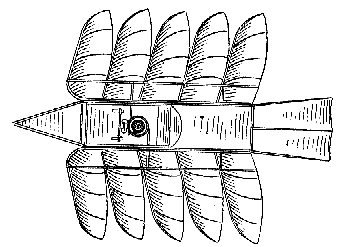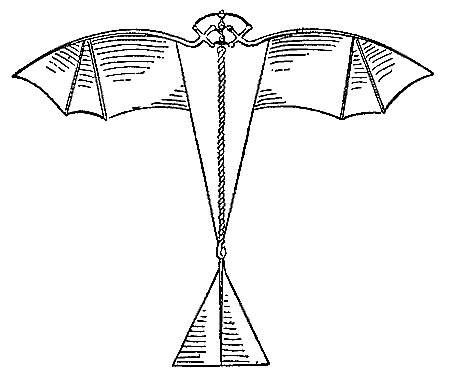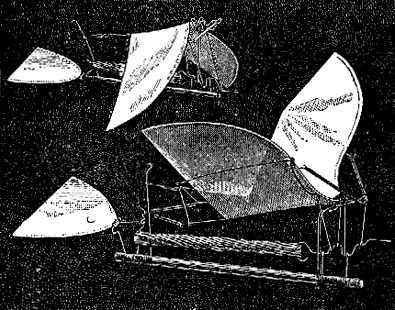
FIG. 12. -- GÉRARD -- 1784.
While the inventors who experimented with flapping wings, with which they tried to raise themselves on the air by muscular effort, doubtless had it in mind eventually to substitute artificial motors, if only they could catch the trick by which the bird flies, there have been a few others who have at the outset designed flapping wings, to be moved by some primary artificial motor. As they generally knew of no such motor, within admissible limits of weight in proportion to its energy, such designs have remained mere projects, and but few experiments have been made
The proposal of Gérard, in 1784, shown in fig. 12, seems to have been among the first. It apparently provides, in addition to the body and wings, for a steering arrangement in front, and for feet with springs to land upon. The inventor omitted to state in his printed description what motive power he intended to use, but an inspection of the drawing suggests the conjecture that the apparatus was to be propelled in part by escaping gases, like a rocket, and in part by flapping the wings through the medium of a gunpowder engine; proposals and experiments with such motors antedating, as is well known, those with the steam-engine. Be this as it may, soon after the success of the locomotive engine on the Liverpool & Manchester Railroad, Mr. F. D. Artingstall endeavored to compass an aerial locomotive. He constructed a very light steam-engine, suspended it by a cord from the ceiling, and to the piston-rod he attached wings, which were so constructed that they opened somewhat like a Venetian blind on the up stroke and closed during the down stroke, moving through an arc of 80°. When steam was turned on the wings worked vigorously, but the machine jerked up and down, rushed from side to side, and, in fact, performed all kinds of gymnastic movements except flight. This experiment was terminated by the explosion of the boiler, and a second attempt, in which it was intended to use four wings instead of two, in order to keep up a continuous buoyancy, resulted in a second explosion; after which the experiments were abandoned. In 1868 Mr. Artingstall, in a communication to the Aeronautical Society of Great Britain, stated the weak point in his various experiments to have been the lack of suitable equilibrium.
Every experimenter with aerial apparatus has doubtless encountered the difficulty of obtaining in a machine that equilibrium which the bird maintains by instinct, and also of deriving continuous support from the flapping of one pair of wings. These are probably the reasons which led Struvé and Telescheff to design, in 1864, the apparatus shown in fig. 13, in which five pairs of wings are attached to a central plane. The only description accessible to the writer states that the wings were moved by human force acting upon a spring, but it is evident that the apparatus was intended to be driven by artificial power, if the designers could only find one sufficiently light for that purpose. That they did not succeed in this seems to be a fair inference from the fact that the machine was not tested by experiment.

FIG. 13. -- STRUVÉ & TELESCHEFF -- 1864.
At the Exhibition of 1868. of the Aeronautical Society of Great Britain. Mr. I. Palmer exhibited a pair of wings (to be driven by power) attached to a rotating axle, and so arranged that they expanded in the descent and closed in the ascent, like the action of a duck's foot in swimming; this motion being obtained in a remarkably simple manner by a roller running on an eccentric cam, which could be instantaneously changed in position, so as to convert the vertical lifting power into one of horizontal force. It does not seem to have been applied to any flying machine.
At the same exhibition Mr. I. M. Kaufmann, engineer of Glasgow, exhibited the working model represented in fig. 14, which was intended as the precursor of an aerial steam machine weighing 7,000 or 8,000 lbs. The apparatus consisted of a steam boiler and engine, mounted upon wheels, and propelled by two long wings, which. during the down stroke, were set at an inclined direction backward, and were caused to turn at a forward angle during the up stroke. The main portion of the weight was to be sustained by superposed aeroplanes, and hence the machine should perhaps be described under that head, but it is here included under the head of wings, because of the mode of propulsion. The model weighed 42 lbs., and during the experiments with it its boiler, owing to its small size, was not fired, steam being supplied from an independent boiler. With steam pressure at 150 lbs. to the inch, the wings made a short series of furious flaps, and one of them suddenly gave way about 2 ft. from its base, upon which the other one failed also. The inventor stated that he was then engaged in the construction of a larger machine on the same principle, but since then nothing more has been heard of it. He proposed to secure stability by letting down or raising up a long "pendule" with telescopic joints, so as to adjust the center of gravity and keep the machine in a horizontal position, but it may well be doubted whether this would have proved effective.
At a meeting of the British Aeronautical Society, in 1871, Mr. R. C. Jay exhibited a model to illustrate a method which he proposed in order to use wings of any length and weight without loss of power. This consisted of two pairs of oscillating wings moving on the same shaft. It was expected that the forces generated by their motion would hold the machine is equilibrium, and that one pair of wings would be aided by the current of air, or whirlpool, produced by the movement of the other pair. This does not seem to have answered, for in 1877 the same inventor presented a model to the same society, illustrating a method of obtaining a figure of 8 or sculling action with one pair of wings, but at the same time Mr. Jay candidly stated that "although he had made a great many experiments, he had not yet succeeded in making a propeller (wings) sufficiently simple and effective for practical purposes."
It is said that about the same time an optician of Leipsic made a small steam bird, mounted on a globular steam boiler and actuated by a cylinder of 2 in. stroke, working wings 32 in. long. This machine would rise vertically 3 ft., the wings making about three beats during the flight, but the boiler limited the performance. It contained spirits of wine only sufficient for 38 seconds, and the apparatus was but a toy.
In 1871 Prigent designed the apparatus shown in fig. 15, which was evidently suggested by the dragon-fly; this is a favorite idea with aviators, who, as we have seen already, have proposed the combination of two pairs of wings over and over again. It was intended to be driven by steam, but although in that same year Moy had produced a steam-engine and boiler weighing but 27 lbs. per horse power, and Stringfellow, in 1868, has shown one claimed to weigh but 13 lbs. per horse power (both applied to aeroplanes), no attempt seems to have been made to experiment with Prigent's device. The fact is, that even the weight of the engines mentioned was too great, for it did not include the fuel and water, which for a noncondensing steam-engine would amount to about 26 lbs. more horse power per hour, and this did not compare favorably with the motive power of birds. The pigeon, for instance, is known, both by dynamometric experiment and computation, to develop in ordinary flight from 160 to 425 foot-pounds of energy per minute for each pound of his weight, and as his pectoral muscles, which constitute his engine, generally compose 10/43 of his weight, we have for the weight of his motor from
(33.000 * 10)/(425 * 43) = 18 lbs. to (33.000 * 10)/(160*43) = 48 lbs.
per horse power developed, including the fuel which enables him to fly for 10 to 12 hours at a stretch.
Hopeless, therefore, of accomplishing anything practical with steam-engines, experimenters with wings next turned their attention to springs or reservoirs of energy of various kinds, and with these they have succeeded in devising a number of toys which fly creditably for a few seconds. Clock springs were first tried, but they were found to be unduly heavy, and in 1871 Jobert brought out his first mechanical bird, shown in fig. 16, driven by indiarubber in tension. The wings were arranged so as to change their plane automatically while flapping, in order to imitate the flexions of the natural wings, and the equilibrium was secured by adjusting the center of gravily so as to correspond with the center of pressure due to the angle of flight.
In 1872 Pénaud who had already succeeded (1870 and 1871) in compassing flight with the superposed screws and with the aeroplane, which will be noticed hereafter, by the force of twisted rubber, applied the same motor to a mechanical bird, which is shown in fig. 17. The wings beat straight down, and the propulsion is obtained from the flexion of their outer edges produced by the reaction of the air. The bird is unable to rise from the ground, but upon being thrown off the hand it first descends some 2 ft., and then, having acquired the initial velocity needed for support, it flies for a distance of 50 ft. in 7 seconds, rising at the same time about 8 or 9 ft. above the point of departure, the equilibrium being perfectly maintained by the tail.
Simultaneously with this M. Hureau de Villeneuve, the permanent Secretary of the French Aeronautical Society, brought out his mechanical bird, which is shown in fig. 18. In this the plane of the wings is inclined at an angle of 45°, and the power is obtained from twisted rubber. In consequence of the peculiar motion of the wings, this model was able to start direct from the ground, but owing to the limited power of the rubber spring it only rose to the height of 4 ft., and then descended, forming a parachute. It was subsequently modified so that it would fly horizontally for a distance of 24 ft., at a velocity of 20 miles per hour.

FIG. 18. -- HUREAU DE VILLENEUVE -- 1872.
M. De Villeneuve has been promoting aviation by flapping wings for the past 25 years. He has, first and last, designed something like 300 experimental models, so that his garret is a complete aviary of artificial birds. He built, some years ago, a huge steam bird on the model of a bat. Being aware that there was at that time no sufficiently light and reliable steam-engine with its boiler to furnish the power required, he placed only the engine on the bird, and connected it by a hose with a boiler on the ground. Upon trial, as soon as the steam was turned on the wings beat violently, and the apparatus rose with the inventor aboard. He grew nervous for for fear that he would get beyond the length of his hose, and shut off steam suddenly, upon which the bird fell and smashed one of its wings. It is still in existence, and the inventor is awaiting the development of a very light motor in order to resume his experiments with this great bird, which is some 50 ft. across.
In 1872 M. Jobert brought out his second mechanical bird, shown in fig. 19. This is driven by twisted rubber, as being more manageable than rubber in tension, and consists of four wings beating alternately in pairs-as a horse trots--in order to produce continuous and uniform support and equilibrium, instead of the jerking motion observable in other apparatus. This flew fairly well, but a measurement of the foot-pounds developed and of the results obtained, in this as well as in the three other mechanical birds previously described, led to the inference that there was great waste of power, as compared with that of birds. This was attributed to the rigidity of the front edge of the wings in all these models, and accordingly in 1876 Tatin took the problem up again and succeeded, by a double eccentric working two levers connected to the front edge of the wing, in giving it a twisting motion similar to that of the bird. His apparatus flew some 65 ft., with rather less weight of rubber.
In 1889 Pichancourt carried the matter still further in the mechanical bird shown in fig. 20, in which there is a triple eccentric, each one actuating a lever fastened to a different point in the wings. His larger models, measuring 171 in. from tip to tip of wings, and weighing 1 1/2 oz., are said to have flown up to a height of 25 ft. and to a distance of 70 ft. against a slightly adverse wind.

FIG. 20. -- PICHANCOURT-- 1889.
Now here are no less than six artifical birds, each with a somewhat different wing- motion, and they all fly, when urged by the energy stored in twisted rubber. The question, therefore, occurs why practicable machines, to carry passengers, cannot be built by substituting some prime mover for the rubber; and the answer is that all these models are so wasteful of power that there is no motor known sufficiently light, in proportion to its energy, to take the place of the rubber. The best that seems to have been done with the latter was to obtain a flight of 7 seconds with flapping wings, and with the expenditure of energy at the rate of 600 foot-pounds per pound of twisted rubber. As there are 550 foot-pounds per second in a horse power, a primary motor, with its supplies, should in the same proportion weigh no more than:
600/(7x550) =6.4 lbs. per horse power,
and there are none such known in practical operation.
Undeterred by this disheartening fact, M. De Louvrié designed, in 1877, the apparatus shown in fig. 21, which he calls the "Anthropornis," and which consists of a pair of wings, resembling those of the swallow, fastened to a hull mounted upon wheels, and intended to be actuated by a steam-engine or a petroleum motor. A spring is to contribute to the downward stroke, and is to be raised by the motor on the up stroke. M. De Louvrié is a veteran in promoting aviation, and his writings show a better understanding and firmer grasp of the question than most of those which nave been published on this intricate subject. He had proposed, in 1863, a sort of kite-like flying machine, which will be noticed under the head of Aeroplanes, and it is said that, in 1888, he presented his latest views before a commission of the French Academy of Sciences, supplementing them with certain experiments, from which he drew the conclusion that an apparatus capable of carrying four passengers needed no more than 3 horse power to drive it at the rate of 67 miles per hour. It may be inferred that the French Commission was not convinced, from the fact that no action has been taken upon the proposal.

FIG. 21. -- DE LOUVRIÉ -- 1877.
| List of Illustrations | Table of Contents | Index |